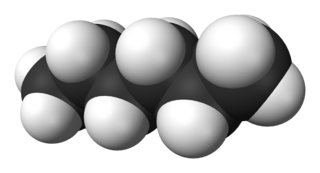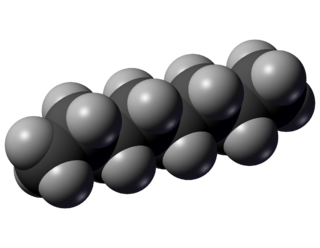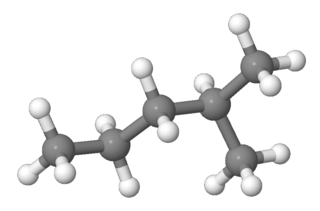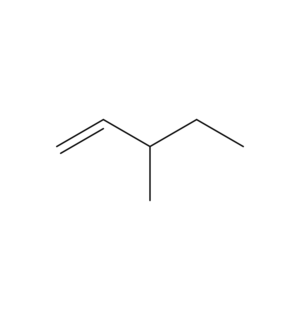The molecular formula C6H14 (molar mass: 86.17 g/mol) may refer to:
- Dimethylbutanes
- Hexane
- Methylpentanes
The molecular formula C6H14 (molar mass: 86.17 g/mol) may refer to:

In organic chemistry, an alkane, or paraffin, is an acyclic saturated hydrocarbon. In other words, an alkane consists of hydrogen and carbon atoms arranged in a tree structure in which all the carbon–carbon bonds are single. Alkanes have the general chemical formula CnH2n+2. The alkanes range in complexity from the simplest case of methane, where n = 1, to arbitrarily large and complex molecules, like pentacontane or 6-ethyl-2-methyl-5-(1-methylethyl) octane, an isomer of tetradecane.
A chemical formula is a way of presenting information about the chemical proportions of atoms that constitute a particular chemical compound or molecule, using chemical element symbols, numbers, and sometimes also other symbols, such as parentheses, dashes, brackets, commas and plus (+) and minus (−) signs. These are limited to a single typographic line of symbols, which may include subscripts and superscripts. A chemical formula is not a chemical name, and it contains no words. Although a chemical formula may imply certain simple chemical structures, it is not the same as a full chemical structural formula. Chemical formulae can fully specify the structure of only the simplest of molecules and chemical substances, and are generally more limited in power than chemical names and structural formulae.

A molecule is an electrically neutral group of two or more atoms held together by chemical bonds. Molecules are distinguished from ions by their lack of electrical charge.

Hexane is an organic compound, a straight-chain alkane with six carbon atoms and has the molecular formula C6H14.

Octane is a hydrocarbon and an alkane with the chemical formula C8H18, and the condensed structural formula CH3(CH2)6CH3. Octane has many structural isomers that differ by the amount and location of branching in the carbon chain. One of these isomers, 2,2,4-trimethylpentane (commonly called iso-octane) is used as one of the standard values in the octane rating scale.
Isomerases are a general class of enzymes that convert a molecule from one isomer to another. Isomerases facilitate intramolecular rearrangements in which bonds are broken and formed. The general form of such a reaction is as follows:

2,2-Dimethylbutane, trivially known as neohexane, is an organic compound with formula C6H14 or (H3C-)3-C-CH2-CH3. It is therefore an alkane, indeed the most compact and branched of the hexane isomers — the only one with a quaternary carbon and a butane (C4) backbone.
Dimethylbutane (DMB) may refer to:
2,3-Dimethylbutane is an isomer of hexane. It has the chemical formula (CH3)2CHCH(CH3)2. It is a colorless liquid which boils at 57.9 °C.
Dioxin may refer to:
3-Methylpentane is a branched alkane with the molecular formula C6H14. It is a structural isomer of hexane composed of a methyl group bonded to the third carbon atom in a pentane chain. It is of similar structure to the isomeric 2-methylpentane, which has the methyl group located on the second carbon of the pentane chain.
Methylpentane may refer to:

2-Methylpentane, trivially known as isohexane, is a branched-chain alkane with the molecular formula C6H14. It is a structural isomer of hexane composed of a methyl group bonded to the second carbon atom in a pentane chain. Using a quantitative structure-activity relationship (QSAR) prediction model, 2-Methylpentane has a research octane number (RON) of 75, motor octane number (MON) of 77, and cetane number (CN) of 29.
The molecular formula C8H18 may refer to:
Octynes are alkynes with one triple bond and the molecular formula C8H14.
Nonynes are alkynes with one triple bond and the molecular formula C9H16.
Dimethylbutanol may refer to:

Methylpentene is an alkene with a molecular formula C6H12. The prefix "methyl-" is derived from the fact that there is a methyl(CH3) branch, the word root "-pent-" is derived from the fact that there are 5 carbon atoms in the parent chain, while the "-ene" suffix denotes that there is a double bond present, as per IUPAC nomenclature. Following are the possible structural isomers of methylpentane:
Heptynes are alkynes with one triple bond and the molecular formula C7H12.